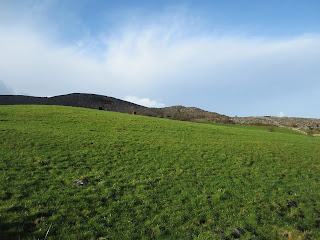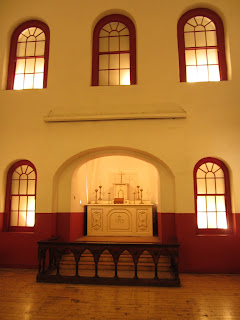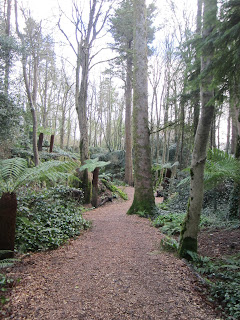After a delightful day in Northern Ireland, we used the final, following day in Dublin to visit Kilmainham Gaol and Trinity College.
Kilmainham Gaol is a former prison that, until its closing, played a very major history in Dublin's and Ireland's history. It was originally built in 1796 and was used to house criminals of all genders, ages, and criminal background-- the youngest prisoner incarcerated there was said to be only five years old. Until the 1820s, people were hanged publicly from balconies out in front of the prison entrance. Prisoners were housed five to cell that measured approximately twenty-eight square meters. And if you were wondering, women would have been often housed in far worse living condition that their male counterparts, making their experiences more overtly awful that the other half of the incarcerated population. While male prisoners were provided with a bedframe and straw to sleep on, women were left to fend for themselves on the cold, limestone floors in the hallways. There was no heat, not enough food, and for the first several years the prison's first floor flooded repeatedly. As a prisoner, I think I'd rather be sent off to Australia-- and make no mistake about it, those who couldn't be crammed into the already-packed cells were.
Kilmainham Gaol was designed using the Victorian era theories and ideas regarding prisoner reformation. It was said that its construction and design, especially in its East Wing, was influenced by Jeremy Bentham's Panopticon, a structure layout that allowed watchmen and guards to see all of the prisoners at once, while prisoners would not be able to tell when they are being watched. In a prison that replicated Bentham's Panopticon exactly, there would be a watchtower placed in the middle of a circular room, with solitary cells around the diameter of the room. Kilmainham, or an prison in history for that matter, is not an exact replica of the Panopticon, but its structure and layout allowed guards to move easily throughout the prison in quell any disturbances in the wings and building.
Kilmainham Gaol is more historical famous, however, for the numerous roles in has played in Ireland's attempts to become a independent nation over the course of the last century and a half. Since its construction it has been the place of imprisonment for every important leader in the Irish nationalist independence movement. Leaders of the rebellions of 1798, 1803, 1848, 1867, and 1916 were jailed here. Have you ever seen Michael Collins? It has Liam Neeson in it and it's a great movie. More or less every character in that movie, with the exception of Michael Collins, was in prison here. Many, if not all of them, who were involved in the Easter Rising were executed here. The prison, now renovated into a museum by the hands and willpower of common Irish citizens, has also laced name placards over the cells where these important leaders, such as Eamonn de Valera, were incarcerated. It's a pretty powerful place.
After leaving Kilmainham, we took another detour through the Temple Bar area in order to get back to to Trinity College.
 |
| Don't expect every room in my house not to have these flowers in them when I get old enough to have a house. |
The Books of Kells, if you care, is a fancily illustrate and painted Latin manuscript of the four Gospels of the New Testament. It is believed to have been created by Celtic monks around 800 by sacramental purposes as opposed to education purposes. You can't take pictures of it, but Wikipedia has pictures of it on its entry for the Book of Kells, as well as all of the fancy history and explanation behind its creation.
| Fancy lettering! |
| Fancy Chi Ro! |
The tour of the Book of Kells also allows you to walk through the Trinity College Long Room, which is super awesome and has like a trillion books in it. Also, you are not supposed to take pictures while inside.
 |
| But I did anyway! |
We spent our first evening in Galway hanging out with some of Emily's old study abroad friends and got pretty good fish and chips as a place called McDonough's. They weren't too shabby.
The next morning, we woke up to catch another tour bus out to the Burren and the Cliffs of Moher. We drove around the edge of Galway Bay and took in some not-too-shabby sights to be seen.
The Burren is a limestone-y mountain-like region of eastern Ireland. It's actually called a karst landscape, which is the result of soluble material, like limestone, eroding and dissolving over time. It leaves all of these deep, wiggly lines that kind of look like some tried to tile a bathroom while blindfolded. The Burren is also (allegedly. I looked this stuff up.) a great example of glacio-karst activity, meaning glaciers rolled over these rocks during the last ice age and really gave the ground the business. Because of all of these little crags in the ground, the Burren is home to a really specific sets of plants and insects that don't thrive anywhere else.
 |
| That big lump of grey is a limestone hill or something. |
 |
| I might concede that the whole "bathroom tile" thing was not the most accurate analogy, but whatever. |
 |
| Made an effort with this house though. Tell me you wouldn't want to live in a house that color and I will call you a liar. |
 |
| Not the real Cliffs of Moher, in case you were wondering. |
 |
| Limestone and stuff! |
Unfortunately, our tour guide (who was not as cool as Troy, may I just say), made it seem as though the American government owned this castle, which it does not, as it is now a private vacation home. Read this as "not open to the public."
 |
| No castles for America. |
But anyway, more about the Cliffs of Moher. It's named after a fort that used to sit atop of part of it, and they rise almost four hundred feet in the air. The oldest rocks the can be seen at the bottom of the cliffs are over three hundred million years old. Is that wild or what?
Now you're just going to be bombarded my pictures of the Cliffs of Moher, because I can't narrow it down to which two or three I like the best. But, they do come with a great story.
So we head out to one viewpoint at O'Brien's Tower, which some guy built to impress the ladies, and we're just appreciating the nature and all that.
Loving geology, if you're into that sort of thing.
 |
| I totally am. |
And the three of us start discussing how lucky we've been in terms of weather in Ireland-- we've had barely any rain, and up until arriving in Galway, the weather has been warmer than it had been in Turkey.
 |
| You know, just admiring the beautiful skyline and stuff. |
 |
| Being a tourist and suffering from some serious chipmunk cheek syndrome. |
 |
| "Rocks are so cool! We love nature!" |
As we're chatting about our great weather, it is about this time that we notice this rain cloud, rain also included, approaching us from the ocean. Here we are, astounded by nature and all of the wonders it has to offer as this impending downpour approaches closer...
 |
| "Wow, this is crazy! That storm is awesome looking!" |
 |
| "Oh wow. This rain isn't stopping." |
We realize that it's not rain, but HAIL the of BB gun ammunition that begins to bombard our faces. And hurts, you guys. It hurts real bad.
 |
| Not too shabby of a picture for a point-and-shoot during what feels like the end of the world, precipitatively speaking. |
Our tour guide urged us to consider coming back to County Clare for this event. Jury's still out on whether he was serious or not.
 |
| Pass. |
We had an impromptu sheep crossing.
 |
| Feel free to make a lamb joke if you are inclined to comment on this post. |
The Poulnabrone Dolmen is a portal tomb in County Clare that dates back to the Neolithic period, somewhere between 4200 and 2900 BC. Aside from the fact that it was in a really pretty place, it's also apparently a very important archaeological excavation site in the area.
The reasons why Neolithic societies built portal tombs are not entirely clear, but archaeologists can at least assume (especially at Poulnabrone) that they are used to demarcate burials or tombs below them.
In the case of Poulnabrone, between sixteen and twenty-two adults and approximately six children were found during an excavation, along with various types of personal items, such as tools, jewelry, pottery, and weapons. Additionally, the body of an infant is believed to have been buried in the front of the monument some time around 1700 BC, leading archaeologists to behind that it was used as a ceremonial monumental well into the Celtic period (like, 450 BC-ish).
Poulnabrone Dolmen was an awesome note on which we could end our tour of the Burren, and we headed back to Galway to hang out with more of Emily's friends that she met while she studied abroad. We got an interesting and exciting taste of the nightlife in Galway, as well as the scantily-clad fashion choices of young Irish females.
The next morning, we bussed on over to Cork, and made to our hotel. This hotel, readers a plenty, gets a special mention. If you're ever in Cork, stay at the Garnish House. First of all, you're given a welcome tea tray upon your arrival, which was perfect, since it was between breakfast and lunch time when we got there. The staff is so nice and extremely helpful, and their breakfast was on point the next day.
 |
| SNACKS ON SNACKS. |
Blarney Castle, home to the Blarney Stone, began in 1200 as a wooden fortress, which was later burned down and rebuilt in 1446. It's been involved in tons of civil wars and tussles with the British and whatnot, and its grounds are really magnificent, but everyone goes to Blarney Castle to kiss the Blarney Stone.
I felt really bad kissing the Blarney Stone. First of all, at least six trillion other people have placed their mouths on this rock. I wouldn't consider myself a germophobe, but that's a little much for me. But you know, you're there, you gotta do it, right?
The real problem, though, is that you're supposed to kiss the Blarney Stone in order to gain the gifts of flattery and eloquence... and these are just things that I have been naturally blessed with. It just doesn't seem fair, that's all.
The walk up the staircase to the Blarney Stone, which is located in a hole in the ground that would have been used to drop things on sieging enemies, was hellaciously dangerous, but also really fun at the same time. Equally as dangerous is the actually kissing of the stone, as they have this kindly old Irishman to lower you to your potential death... all in the name of eloquence.
 |
| He was very lovely, though. |
 |
| All this for the gift of gab. |
Such as:
 |
| Yew! |
 |
| Hellebore! |
 |
| Deadly nightshade! |
 |
| Wormwood! |
 |
| Mandrake root! |
The Poison Garden also had some other surprising residents within its walls, like tea. Really, Blarney Castle. Apparently, tea is included in the garden due to the fact that it contains caffeine. Whatevs.
 |
| Don't tell the Turks though. |
 |
| Hilarious. |
As I was trying to get Emily to take an on point jump shot, an older lady began walking toward us. She stopped to chat with us, asking us where we were from, what we were doing in Ireland, all those niceties. She told us that she'd been living on the estate grounds since 1954! She was so nice, we should have taken a picture with her. At least she lives on in the background of this jump shot.
I'd say that Cork and Blarney Castle were just about the prettiest places I've ever... at least in 2012, for sure.
Plus: when we left Cork for Barcelona the next morning, there was a rainbow! Tell me that ain't perfectly Irish!












































No comments:
Post a Comment